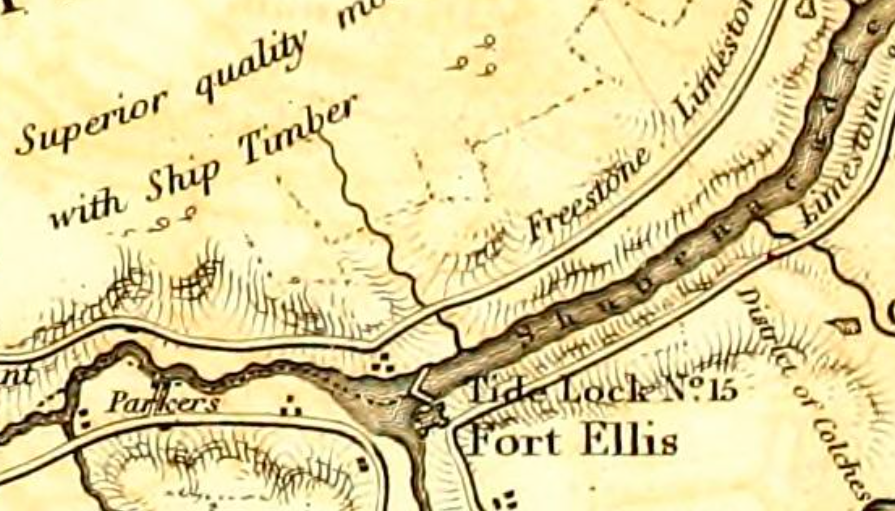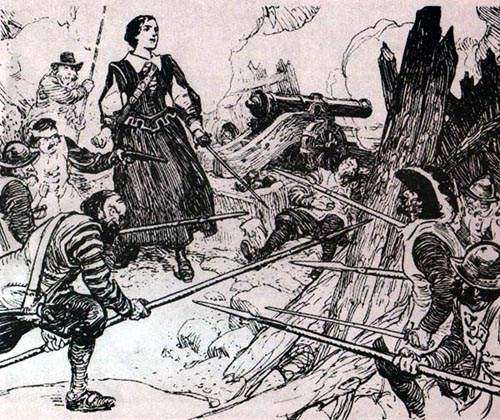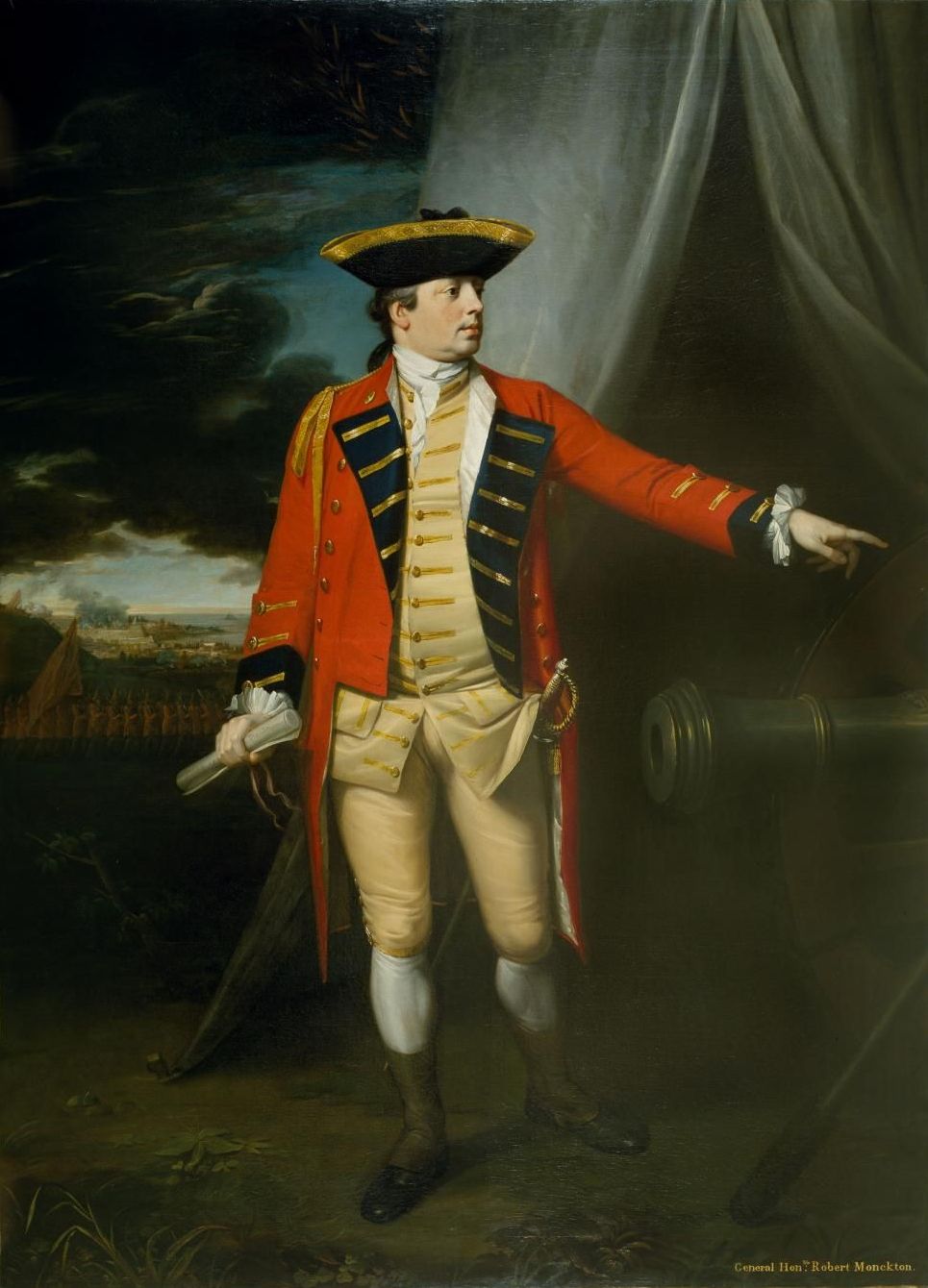|
Fort Ellis, Nova Scotia
Fort Ellis was a British fort or blockhouse built during the French and Indian War, located at the junction of the Shubenacadie and Stewiacke Rivers, close to Stewiacke, Nova Scotia, Canada. The location was labelled Ville Pierre Hebert by Charles Morris. The 14 Acadian families in the area vacated with the Acadian Exodus. Charles Morris recommended a Fort on the Shubenacadie River in 1753. Governor Lawrence first considered the fort in 1754 as a means to protect Halifax from Mi'kmaq raids. Lawrence decided the fort would not be effective until after the Battle of Fort Beauséjour. The fort was completed on October 18, 1761, shortly after the Halifax Treaties were signed. The fort was to guard the new road built to connect Truro and Halifax against Mi'kmaq raids. The fort was called Fort Ellis after Governor Henry Ellis, who was appointed governor weeks after the forts completion. The fort was never garrisoned and eventually abandoned in 1767. Fort Belcher, named after Governor ... [...More Info...] [...Related Items...] OR: [Wikipedia] [Google] [Baidu] |
Fort Ellis, Nova Scotia
Fort Ellis was a British fort or blockhouse built during the French and Indian War, located at the junction of the Shubenacadie and Stewiacke Rivers, close to Stewiacke, Nova Scotia, Canada. The location was labelled Ville Pierre Hebert by Charles Morris. The 14 Acadian families in the area vacated with the Acadian Exodus. Charles Morris recommended a Fort on the Shubenacadie River in 1753. Governor Lawrence first considered the fort in 1754 as a means to protect Halifax from Mi'kmaq raids. Lawrence decided the fort would not be effective until after the Battle of Fort Beauséjour. The fort was completed on October 18, 1761, shortly after the Halifax Treaties were signed. The fort was to guard the new road built to connect Truro and Halifax against Mi'kmaq raids. The fort was called Fort Ellis after Governor Henry Ellis, who was appointed governor weeks after the forts completion. The fort was never garrisoned and eventually abandoned in 1767. Fort Belcher, named after Governor ... [...More Info...] [...Related Items...] OR: [Wikipedia] [Google] [Baidu] |
Henry Ellis (governor)
Henry Ellis (August 29, 1721 – January 21, 1806) was an Irish explorer, author and slave trader who served as the governor of the colonies of Georgia and Nova Scotia. Biography Early years Ellis was born August 29, 1721, in County Monaghan, Ireland, the son of Francis and Joan (''née'' Maxwell) Ellis. He studied law at the Middle Temple in London. In May 1746, he went out as agent of a company for the discovery of the Northwest Passage. After extinguishing with difficulty a fire in his ship, he sailed to Greenland, where he exchanged commodities with the Inuit peoples on July 8. He then proceeded to Fort Nelson and wintered in Hayes River. He renewed his efforts in June 1747, without success, and returned to England where he arrived on October 14. He published an account of his explorations in 1748, entitled ''A voyage to Hudson's-Bay by the ''Dobbs Galley'' and ''California'' in the years 1746 and 1747 for discovering a North West Passage''" and in 1750 published ''Cons ... [...More Info...] [...Related Items...] OR: [Wikipedia] [Google] [Baidu] |
Military Forts In Nova Scotia
A military, also known collectively as armed forces, is a heavily armed, highly organized force primarily intended for warfare. It is typically authorized and maintained by a sovereign state, with its members identifiable by their distinct military uniform. It may consist of one or more military branches such as an army, navy, air force, space force, marines, or coast guard. The main task of the military is usually defined as defence of the state and its interests against external armed threats. In broad usage, the terms ''armed forces'' and ''military'' are often treated as synonymous, although in technical usage a distinction is sometimes made in which a country's armed forces may include both its military and other paramilitary forces. There are various forms of irregular military forces, not belonging to a recognized state; though they share many attributes with regular military forces, they are less often referred to as simply ''military''. A nation's military may f ... [...More Info...] [...Related Items...] OR: [Wikipedia] [Google] [Baidu] |
Military History Of Nova Scotia
Nova Scotia (also known as Mi'kma'ki and Acadia) is a Canadian province located in Canada's Maritimes. The region was initially occupied by Mi'kmaq. The colonial history of Nova Scotia includes the present-day Canadian Maritime provinces and the northern part of Maine ( Sunbury County, Nova Scotia), all of which were at one time part of Nova Scotia. In 1763 Cape Breton Island and St. John's Island (now Prince Edward Island) became part of Nova Scotia. In 1769, St. John's Island became a separate colony. Nova Scotia included present-day New Brunswick until that province was established in 1784. (In 1765, the county of Sunbury was created, and included the territory of present-day New Brunswick and eastern Maine as far as the Penobscot River.) During the first 150 years of European settlement, the colony was primarily made up of Catholic Acadians, Maliseet and Mi'kmaq. During the latter seventy-five years of this time period, there were six colonial wars that took place in Nova Sc ... [...More Info...] [...Related Items...] OR: [Wikipedia] [Google] [Baidu] |
Fort Morris (Nova Scotia)
Fort Morris was a British fort or blockhouse built during the French and Indian War, located at Liverpool, Nova Scotia. The fort was located at present-day Fort Point Lighthouse, while a surrounding blockhouse was at the corner of Lawrence and Wolfe Streets. (In 1762, the blockhouse was occupied by Lieut. Jonathan Diman Ebenezer Dexter). The fort was completed shortly after Liverpool was established and the Halifax Treaties were signed (1759-1760). The fort was a local militia five-gun earthwork battery. Fort Morris was named after Surveyor General Charles Morris, who designed the layout of the town. (The fort was built the same time as Fort Ellis and Fort Belcher.) American Revolution In the 1770s, Liverpool was the second-largest settlement in Nova Scotia, after Halifax. Unlike Halifax, nearly everyone in Liverpool was a New England Planter. The town was at first sympathetic to the cause of the American Revolution, with outlying outports like Port Medway and Port Mouton a ... [...More Info...] [...Related Items...] OR: [Wikipedia] [Google] [Baidu] |
Michael Francklin
Michael Francklin or Franklin (6 December 1733 – 8 November 1782) served as Nova Scotia's Lieutenant Governor from 1766 to 1772. He is buried in the crypt of St. Paul's Church (Halifax). Early life and immigration Born in Poole, England, Francklin immigrated to Halifax, Nova Scotia in 1752. He worked as a trader and merchant, initially in association with Joshua Maugher. Capture During Father Le Loutre's War, Michael Francklin was captured by a Mi'kmaw raiding party in 1754 and held captive for three months in which he learned the Mi'kmaw language and developed an appreciation for native culture. Political career Francklin represented Lunenburg County from 1759 to 1760 and Halifax County from 1761 to 1762 in the Nova Scotia House of Assembly. On February 7, 1762, Francklin married Susannah Boutineau. In May of that year, he was named to the Nova Scotia Council. In the early 1770s, he was responsible for bringing about the Yorkshire Emigration. He also played an impor ... [...More Info...] [...Related Items...] OR: [Wikipedia] [Google] [Baidu] |
Tatamagouche
Tatamagouche (Mi'kmaq: ''Taqamiju’jk'') is a village in Colchester County, Nova Scotia, Canada. Tatamagouche is situated on the Northumberland Strait 50 kilometres north of Truro and 50 kilometres west of Pictou. The village is located along the south side of Tatamagouche Bay at the mouths of the French and Waugh Rivers. Tatamagouche derives its name from the native Mi'kmaq term ''Takǔmegoochk'', translated as "Meeting of the waters". Early history The first European settlers in the Tatamagouche area were the French Acadians, who settled the area in the early 18th century, and Tatamagouche became a transshipment point for goods bound for Fortress of Louisbourg. Battle at Tatamagouche During King George's War, New England was engaged in the Siege of Louisbourg (1745) in their efforts to defeat the French. On June 15, 1745, Captain Donahew confronted Lieut. Paul Marin de la Malgue's allied force who was en route from Annapolis Royal to Louisbourg. The French convoy of ... [...More Info...] [...Related Items...] OR: [Wikipedia] [Google] [Baidu] |
Lower Onslow, Nova Scotia
Lower Onslow is a small community in the Canadian province of Nova Scotia Nova Scotia ( ; ; ) is one of the thirteen provinces and territories of Canada. It is one of the three Maritime provinces and one of the four Atlantic provinces. Nova Scotia is Latin for "New Scotland". Most of the population are native Eng ..., located in Colchester County. ReferencesLower Onslow on Destination Nova Scotia Communities in Colchester County General Service Areas in Nova Scotia {{ColchesterNS-geo-stub ... [...More Info...] [...Related Items...] OR: [Wikipedia] [Google] [Baidu] |
Jonathan Belcher (jurist)
Jonathan Belcher (July 23, 1710 – March 30, 1776) was a British-American lawyer, chief justice, and Colonial Governor of Nova Scotia. Biography Born in Boston, Massachusetts, the second son of Jonathan Belcher and Mary Partridge, Belcher entered Harvard College, where in 1728 he received a Bachelor of Arts degree. In 1731 he proceeded to Master of Arts, also at Harvard. In 1730, he entered the Middle Temple, London, to read law, and in 1734 was called to the English bar. In the meantime he had been admitted as a fellow-commoner to Trinity College, Cambridge, where in 1733 he received another master's degree in mathematics. He later received a third master's degree from the College of New Jersey (now Princeton University). In 1754, Belcher was sent to Nova Scotia to become the first Chief Justice of the Nova Scotia Supreme Court. Prior to Belcher's arrival Nova Scotia had no formally trained law officers. He also served on the Nova Scotia Council. On July 28, 1755, he pub ... [...More Info...] [...Related Items...] OR: [Wikipedia] [Google] [Baidu] |
Halifax Treaties
The Peace and Friendship Treaties were a series of written documents (or, treaties) that Britain signed between 1725 and 1779 with various Mi’kmaq, Wolastoqiyik (Maliseet), Abenaki, Penobscot, and Passamaquoddy peoples (i.e., the Wabanaki Confederacy) living in parts of what are now the Maritimes and Gaspé region in Canada and the northeastern United States. Primarily negotiated to reaffirm the peace after periods of war and to facilitate trade, these treaties remain in effect to this day. The Peace and Friendship Treaties include the Halifax Treaties. These are 11 treaties signed between 1760 and 1761 by the various bands of the Miꞌkmaq (as well as other Indigenous peoples)There were also Halifax Treaties signed with the Wolastoqiyik (Maliseet) and the Passamaquoddy. and the British in Halifax, Nova Scotia. These agreements ended the conflict that had persisted between the two peoples for 85 years. The Halifax Treaties include both military submissions—or oaths of alleg ... [...More Info...] [...Related Items...] OR: [Wikipedia] [Google] [Baidu] |
Fort Ellis
Fort Ellis was a United States Army fort established August 27, 1867, east of present-day Bozeman, Montana. Troops from the fort participated in many major campaigns of the Indian Wars. The fort was closed on August 2, 1886. History The fort was established by the War Department to protect and support settlers moving into the Gallatin Valley of Montana. The post was named for Colonel Augustus van Horne Ellis, an American soldier killed in 1863 at the Battle of Gettysburg during the Civil War. Five troops of the 2nd US Cavalry Regiment and infantry companies from the 7th Infantry Regiment provided the fort's garrison. Nearby Fort Elizabeth Meagher, which was established in the spring of 1867 on Rocky Creek, was abandoned after Fort Ellis was built. Fort Ellis was an important post during the prominent Indian Wars of the 19th century as well as a base of operations for exploring the region now known as Yellowstone National Park. In January 1870, Major Eugene M. Baker led ele ... [...More Info...] [...Related Items...] OR: [Wikipedia] [Google] [Baidu] |
Battle Of Fort Beauséjour
The Battle of Fort Beauséjour was fought on the Isthmus of Chignecto and marked the end of Father Le Loutre's War and the opening of a British offensive in the Acadia/Nova Scotia theatre of the Seven Years' War, which would eventually lead to the end of the French colonial empire in North America. The battle also reshaped the settlement patterns of the Atlantic region, and laid the groundwork for the modern province of New Brunswick. Beginning June 3, 1755, a British army under Lieutenant-Colonel Robert Monckton staged out of nearby Fort Lawrence, besieged the small French garrison at Fort Beauséjour with the goal of opening the Isthmus of Chignecto to British control. Control of the isthmus was crucial to the French because it was the only gateway between Quebec and Louisbourg during the winter months. After two weeks of siege, Louis Du Pont Duchambon de Vergor, the fort's commander, capitulated on June 16. Historical context Tensions between the English and the French con ... [...More Info...] [...Related Items...] OR: [Wikipedia] [Google] [Baidu] |



.jpg)


